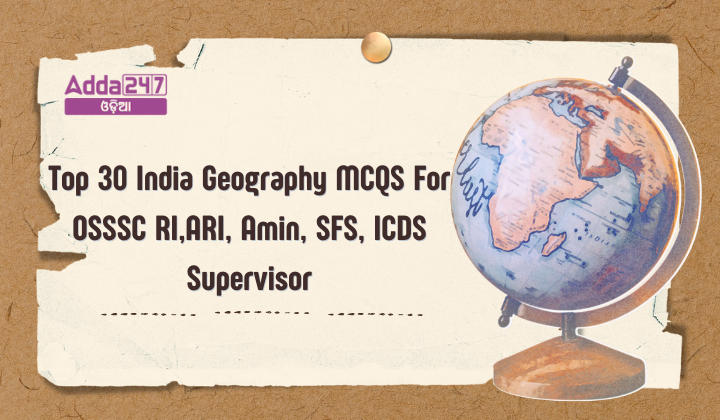Preparing for competitive exams such as OSSSC RI (Revenue Inspector), ARI (Assistant Revenue Inspector), Amin, SFS, or ICDS Supervisor often requires a strong grasp of historical events. Modern history, especially, forms a significant part of the syllabus, covering crucial periods and events that shaped the world as we know it today. To aid in your preparation, here are 30 multiple-choice questions (MCQs) focusing on modern history:
Top 30 Geography MCQS For OSSSC RI,ARI, Amin, SFS, ICDS Supervisor
- Where are Tropical Evergreen rain forests predominantly found in India?
(a) Western Ghats
(b) Deccan Plateau
(c) Punjab and Haryana
(d) Central India
Ans. (a) Western Ghats - Which tree species is NOT commonly found in Tropical Evergreen rain forests?
(a) Mahogany
(b) Sandalwood
(c) Teak
(d) Rosewood
Ans. (c) Teak - Deciduous forests in India are found in which of the following regions?
(a) Western Ghats
(b) Arunachal Pradesh
(c) Central Deccan Plateau
(d) Andaman Islands
Ans. (c) Central Deccan Plateau - What is the primary reason why Dry Deciduous forests are characterized?
(a) High annual precipitation
(b) Low annual precipitation
(c) Rich biodiversity
(d) Evergreen vegetation
Ans. (b) Low annual precipitation - Which type of forest is characterized by a multilayered structure with intense tree growth and high biodiversity?
(a) Deciduous forests
(b) Tidal or Mangrove forests
(c) Tropical Evergreen forests
(d) Semi-desert vegetation
Ans. (c) Tropical Evergreen forests - Which trees are commonly found in the higher elevations of the Himalayas?
(a) Rhododendrons and Junipers
(b) Sal and Teak
(c) Pine and Fir
(d) Bamboo and Mahogany
Ans. (a) Rhododendrons and Junipers - What is a significant feature of Mangrove forests?
(a) High altitude location
(b) Low annual precipitation
(c) Growth near coastal areas and deltas
(d) Presence of tropical hardwood trees
Ans. (c) Growth near coastal areas and deltas - Which of the following is NOT a typical tree found in Tidal or Mangrove forests?
(a) Sundari
(b) Hogla
(c) Sal
(d) Garan
Ans. (c) Sal - Where are Semi-desert and Desert vegetation primarily found in India?
(a) Himachal Pradesh
(b) Punjab and Rajasthan
(c) West Bengal
(d) Meghalaya
Ans. (b) Punjab and Rajasthan - Why does Tropical Evergreen rain forest not regenerate quickly compared to Deciduous forests?
(a) Exotic species invade the fertile soil
(b) The soil is deficient in nutrients
(c) Rain forest species are slow-growing
(d) Propagules of the trees have poor viability
Ans. (b) The soil is deficient in nutrients - What is the primary action of weathering on Earth?
a) Formation of new rocks
b) Erosion of sediments
c) Disintegration of rocks
d) Creation of mountains
Ans. c) Disintegration of rocks - Which of the following is NOT a major group of weathering processes?
a) Biological Weathering
b) Chemical Weathering
c) Physical or Mechanical Weathering
d) Erosion Weathering
Ans. d) Erosion Weathering - What role do climate and atmospheric conditions play in weathering?
a) They have no effect on weathering processes.
b) They influence the rate and type of weathering.
c) They only affect physical weathering.
d) They are solely responsible for chemical weathering.
Ans. b) They influence the rate and type of weathering. - Which weathering process involves the fragmentation of rocks by biological agents?
a) Chemical Weathering
b) Physical Weathering
c) Biological Weathering
d) Thermal Weathering
Ans. c) Biological Weathering - How does physical or mechanical weathering differ from chemical weathering?
a) Physical weathering involves chemical reactions, while chemical weathering involves physical forces.
b) Physical weathering is caused by biological agents, whereas chemical weathering is caused by physical forces.
c) Physical weathering is caused by physical forces, whereas chemical weathering involves chemical reactions.
d) Physical weathering only affects minerals, while chemical weathering affects organic materials.
Ans. c) Physical weathering is caused by physical forces, whereas chemical weathering involves chemical reactions. - Which of the following factors influences the degree of weathering?
a) Only climatic factors
b) Only biological factors
c) Geological, climatic, topographic, and vegetative factors
d) Only atmospheric conditions
Ans. c) Geological, climatic, topographic, and vegetative factors - What determines the resistance of minerals to weathering?
a) Their color and size
b) The depth of the weathering mantle
c) Their formation pressure and temperature
d) Their age and location
Ans. c) Their formation pressure and temperature - Which type of weathering is characterized by the weakening of rocks through chemical reactions?
a) Physical Weathering
b) Mechanical Weathering
c) Biological Weathering
d) Chemical Weathering
Ans. d) Chemical Weathering - What is the primary cause of biological weathering?
a) Water and ice
b) Wind and temperature changes
c) Plants, animals, and microbes
d) Chemical reactions in the atmosphere
Ans. c) Plants, animals, and microbes - In what way does the weathering process differ from erosion?
a) Weathering involves the transport of materials, whereas erosion does not.
b) Weathering breaks down materials in situ, while erosion involves the movement of materials.
c) Weathering is only a chemical process, while erosion is purely physical.
d) Weathering and erosion are identical processes.
Ans. b) Weathering breaks down materials in situ, while erosion involves the movement of materials. - What does biodiversity primarily refer to?
(a) The number of different species in a specific region
(b) The number of individuals of a single species
(c) The climate conditions in a region
(d) The geographical features of an area
Ans: (a) The number of different species in a specific region - Which role does biodiversity play in maintaining ecological balance?
(a) It decreases the stability of the ecosystem
(b) It regulates the production and decomposition of organic waste
(c) It focuses solely on economic benefits
(d) It creates artificial habitats
Ans: (b) It regulates the production and decomposition of organic waste - What is a major economic role of biodiversity?
(a) Creating artificial habitats
(b) Providing raw materials for industrial products like oils and perfumes
(c) Decreasing the number of plant species
(d) Reducing soil fertility
Ans: (b) Providing raw materials for industrial products like oils and perfumes - How does biodiversity contribute to scientific knowledge?
(a) By focusing only on economic aspects
(b) By providing evidence of life’s evolution and species’ roles in sustainability
(c) By decreasing the variety of species
(d) By ignoring the role of ecosystems
Ans: (b) By providing evidence of life’s evolution and species’ roles in sustainability - Which type of biodiversity refers to the diversity within species?
(a) Ecosystem Diversity
(b) Genetic Diversity
(c) Species Diversity
(d) Environmental Diversity
Ans: (b) Genetic Diversity - What is meant by species diversity?
(a) The variety of ecosystems in a region
(b) The number of different species within a specific region or habitat
(c) The genetic makeup of individual species
(d) The economic benefits derived from species
Ans: (b) The number of different species within a specific region or habitat - Which of the following is a cause of biodiversity loss?
(a) Natural habitat preservation
(b) Decreased demand for natural resources
(c) Pollution and climate change
(d) Increased forestation
Ans: (c) Pollution and climate change - What impact do natural calamities have on biodiversity?
(a) They help in increasing species diversity
(b) They lead to loss of biodiversity
(c) They preserve habitats
(d) They create new ecosystems
Ans: (b) They lead to loss of biodiversity - How does air pollution contribute to biodiversity loss?
(a) By increasing species diversity
(b) By enhancing the carbon dioxide levels, leading to climate change
(c) By reducing the temperature of land and oceans
(d) By encouraging species adaptation
Ans: (b) By enhancing the carbon dioxide levels, leading to climate change - What role do plants play in the context of biodiversity and medicinal use?
(a) They have no role in medicinal use
(b) They are used primarily for industrial products
(c) They are essential for producing anti-cancer drugs
(d) They contribute to air pollution
Ans: (c) They are essential for producing anti-cancer drugs
















